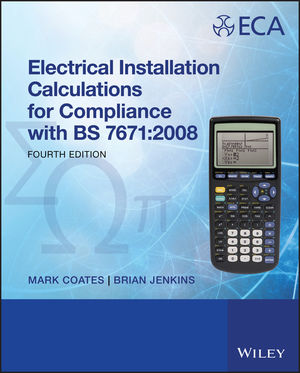Electrical Installation Calculations: For Compliance with BS 7671:2008, 4th EditionISBN: 978-1-4443-2426-6
Paperback
216 pages
August 2010, Wiley-Blackwell
 |
||||||
About the authors vii
Preface ix
Acknowledgements xi
Symbols xiii
Definitions xv
1 Calculation of the cross-sectional areas of circuit live conductors 1
General circuits 4
Circuits in thermally insulating walls 5
Circuits totally surrounded by thermally insulating material 6
Circuits in varying external influences and installation conditions 6
Circuits in ventilated trenches 8
Circuits using mineral-insulated cables 9
Circuits on perforated metal cable trays 10
Circuits in enclosed trenches 11
Circuits buried in the ground 14
Grouped circuits not liable to simultaneous overload 18
Circuits in low ambient temperatures 24
Grouped ring circuits 26
Motor circuits subject to frequent stopping and starting 27
Circuits for star-delta starting of motors 29
Change of parameters of already installed circuits 30
Admixtures of cable sizes in enclosures 33
Grouping of cables having different insulation 39
2 Calculation of voltage drop under normal load conditions 40
The simple approach 40
The more accurate approach taking account of conductor operating temperature 43
The more accurate approach taking account of load power factor 55
The more accurate approach taking account of both conductor operating temperature and load power factor 58
Voltage drop in ring circuits 59
Voltage drop in ELV circuits 62
3 Calculation of earth fault loop impedance 65
The simple approach 70
The more accurate approach taking account of conductor temperature 75
Calculations taking account of transformer impedance 81
Calculations concerning circuits fed from sub-distribution boards 82
Calculations where conduit or trunking is used as the protective conductor 87
Calculations where cable armouring is used as the protective conductor 94
4 Calculations concerning protective conductor cross-sectional area 101
Calculations when the protective device is a fuse 104
Calculations when an external cpc is in parallel with the armour 111
Calculations when the protective device is an mcb 113
Calculations when the protective device is an RCD or RCBO 119
5 Calculations related to short circuit conditions 126
a.c. single-phase circuits 127
The more rigorous method for a.c. single-phase circuits 135
a.c. three-phase circuits 141
6 Combined examples 153
Appendix: The touch voltage concept 175
Index 189



